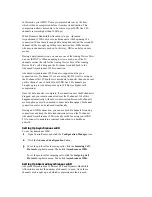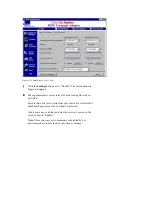
For information on dialing for an AO/DI connection, see the chapter
“Dialing, Storing Numbers, and Logging Calls.”
Managing AO/DI Operations
A check box in the “AO/DI Operations” section enables or disables the
Request Reverse Charge operation.
Request Reverse Charge allows you to request that the charge for an
X.25 connection on your ISDN TA’s D-channel be paid by the
recipient of the call.
Note: This service must be supported by the device or service provider
that you are connecting to.
To enable this feature, select Enable Request Reverse Charge. A
check mark appears in the box next to the item when it is enabled.
In the “AO/DI Operations” section, you can also set the number of B-
channels being managed by AO/DI.
Click the Maximum AO/DI Bandwidth drop-down menu.
If you want AO/DI to have control over only the D-channel of
your ISDN line, click D-channel Only.
If you want AO/DI to be able to engage one of your B-channels
when necessary, click D-c 1 B-channel.
If you want AO/DI to be able to engage both B-channels when
necessary, click D-c 2 B-channels.
Using Asynchronous 128K and Advanced
Asynchronous 128K
Asynchronous 128K data protocol mode bonds your ISDN line’s two
B-channels together. It is a 3Com proprietary channel aggregation
method for achieving speeds up to 128 Kbps.
Asynchronous 128K is similar to hardware B-channel BONDING, but
it provides more features and flexibility.
During a data transmission, you can use one of the Analog Device Ports
on your ISDN TA. When an analog device is used, one of the B-
channels is removed from the Asynchronous 128K connection and
carries the call for the Analog Device Port. After Analog Device Port’s
call is dropped, the B-channel is added back to the Asynchronous 128K
connection.
It assumes that error correction, if required, will be handled on an upper
layer. Data is delivered to its destination with minimum delay.
Advanced Asynchronous 128K
Advanced Asynchronous 128K has the same basic functionality as
Asynchronous 128K. Like Asynchronous 128K, it is also a 3Com
proprietary channel aggregation method.






























